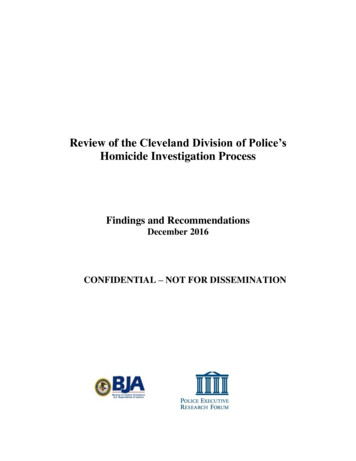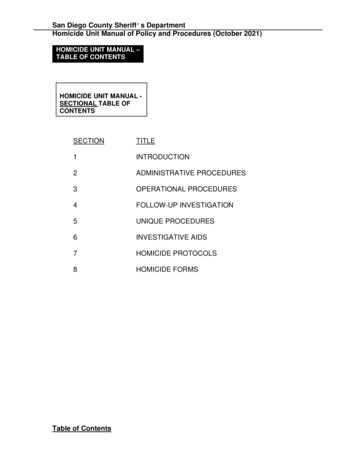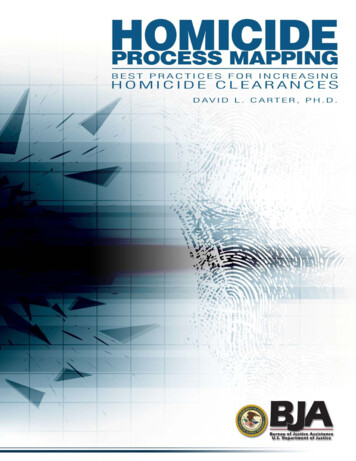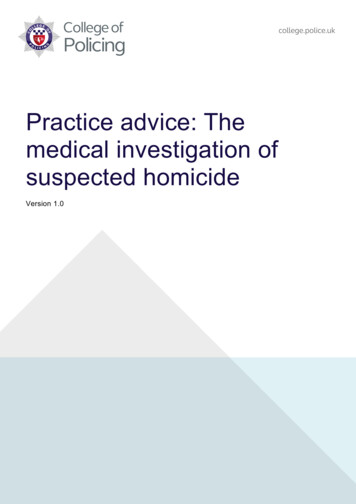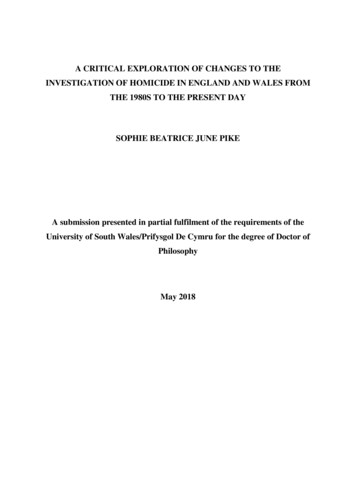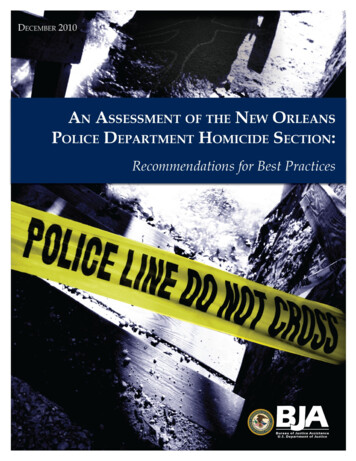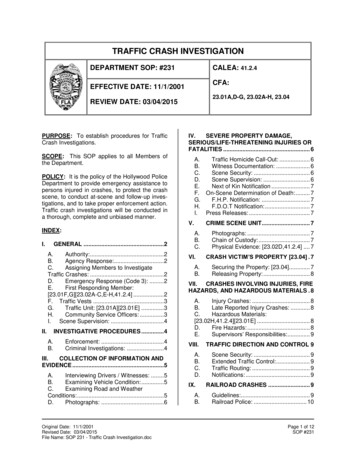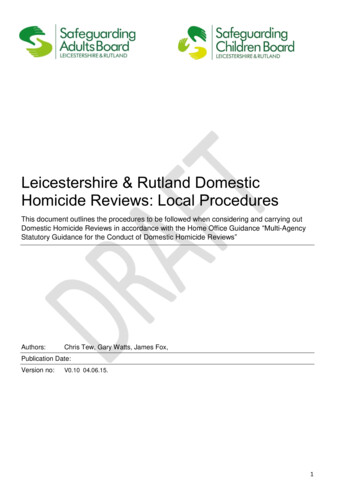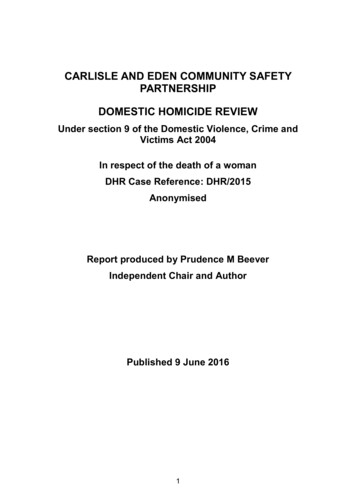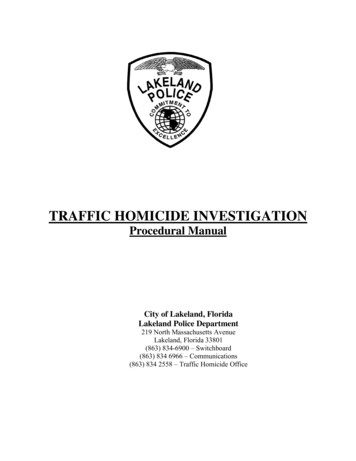
Transcription
TRAFFIC HOMICIDE INVESTIGATIONProcedural ManualCity of Lakeland, FloridaLakeland Police Department219 North Massachusetts AvenueLakeland, Florida 33801(863) 834-6900 – Switchboard(863) 834 6966 – Communications(863) 834 2558 – Traffic Homicide Office
The following information outlined in this manual is to be utilized as a guideline for completing Traffic HomicideInvestigations. The objective is to define the parameters utilized by traffic homicide investigators. This manualsupports the Lakeland Police Department General Orders, Policy 24-3.9.A.B.OVERVIEW OF TRAFFIC HOMICIDE INVESTIGATIONS1.A fatal crash investigation is a two-part investigation, the first is the original traffic crashinvestigation and the second is the Traffic Homicide Investigation. The post crash investigationwill be investigated by a Traffic Homicide Investigator. A Traffic Homicide Investigation isinitiated when a person dies or is suspected of dying as a result of a traffic crash.2.If a Medical Crash Report is completed by an attending physician, this form will be included inthe case file and the case shall be closed and a traffic homicide investigation will not becompleted.3.The original of the Florida Traffic Crash Report is completed by a member, who will note on theoriginal crash report the name, rank, and identification number of the Traffic HomicideInvestigator assigned to the crash. All members who have responded to the scene of potentiallyfatal crash that have relevant firsthand knowledge regarding the investigation will document anyinformation and actions on a Crash Continuation and/or a Traffic Homicide Supplemental Report.a. The Traffic Homicide Investigative Report will be completed by the TrafficHomicide Investigator. In order to maintain a standardized case management systemfor the accountability, immediate retrieval, and status of investigations conducted byTraffic Homicide Investigators, it is imperative that the following procedures arecompleted as outlined.1. The Traffic Homicide Investigator will update the Traffic HomicideInvestigation Tracking System (T.H.I.T.S.) as soon as possible. The TrafficHomicide Investigator is responsible for uploading any changes to the T.H.I.T.S.to the network. Refer to Section D of this manual for further information on theT.H.I.T.S.2. If additional work is needed on the case that may slow down the progress ofcompletion, the Traffic Supervisor and Traffic Homicide Investigator willdiscuss the proper method to be used and how to best continue the investigation.3. The Traffic Supervisor will conduct a case review of all Traffic Homicide CaseFiles to include, all notes, witnesses statements, photographs, medical examinersreport(s) and case report(s).4. In cases involving criminal charges, the Traffic Supervisor is to ensure that allelements necessary for prosecution are included. The Traffic Supervisor willcomplete a full review of the case file prior to submission to the State Attorney’sOffice.5. In cases involving civil charges, the Traffic Supervisor is to ensure that allelements necessary for prosecution are included. The Traffic Supervisor willcomplete a full review of the case file prior to submission to the Clerk of theCourt.TRAFFIC HOMICIDE INVESTIGATOR IMMEDIATE RESPONSIBILITIESWhen a traffic crash is determined to be fatal or potentially fatal, per G.O. 24-3, LPD communications willattempt to dispatch any available traffic personnel to the scene. If a fatal crash occurs during a time periodwhen no crash investigators are on duty, the first responding officer will notify a Patrol Supervisor of theincident. A patrol supervisor will respond, ascertain the details and contact the Traffic Section OIC. Thepatrol supervisor will initiate a “Supervisor’s Checklist for Traffic Fatalities” and turn it over to the firstTraffic Homicide Member upon their arrival.The Traffic Section OIC will assume responsibility fornotifying and off-duty Traffic Supervisor.The Traffic Supervisor will contact the Traffic Homicide Investigator who will respond to the scene andinvestigate the incident. The Traffic Homicide Investigator will be responsible to ensure that all of thenecessary tasks are completed for a successful investigation.Page 2 of 10
C.CLASSIFICATIONS OF FATAL CRASHES1. A fatal crash investigation shall be broken down into three (3) categories as outlined below. Any fatalcrash that results in a complex investigation where additional documentation is necessary may be listedas a Class 1 Investigation.a.Class 1 Investigation: This format will be used in any fatal crash investigation that mayresult in Vehicular Homicide and/or DUI Manslaughter charges. During these investigations theunit will interview witnesses and obtain taped statements, laser map the scene, obtain coefficientof frictions, take photographs, and any other task deemed appropriate by the Traffic HomicideInvestigator. The Traffic Homicide Investigator may attend Class 1 Autopsy’s if foul play issuspected. A Traffic Homicide Investigators Release will be forwarded with the case file forsignature by the Office of the State Attorney.b.Class 2 Investigation: This format will be used in any fatal crash investigation where theat-fault driver is deceased or only civil charges apply. During these investigations, the unit mayconduct any task that may be deemed appropriate by the Traffic Homicide Investigator. TheTraffic Homicide Investigator may choose not to fully reconstruct the crash or have the sworntaped statements transcribed when it is clear that the at-fault driver is deceased. The TrafficHomicide Investigator may attend a Class 2 Autopsy if necessary. A public records release willaccompany the case file up the chain of command for signature by the Traffic Section OIC.c.Class 3 Investigation: This format will be used in all other fatal crash investigations. Anexample of this would be the utilization of the Medical Crash Report or a single vehicle crash.The Traffic Homicide Investigator may have to attend a Class 3 Autopsy for the purpose ofdetermining the cause of death. During these investigations it may be deemed appropriate to sendthe Traffic Homicide Investigator to the scene to determine if a more extensive on-sceneinvestigation is required. A public records release will accompany the case file up the chain ofcommand for signature by the Traffic Section OIC.2. The on-call Criminal Investigations Section Supervisor shall be notified on any fatal crash that occursand evidence reveals foul play exists. The Traffic Homicide Investigator will assist CIS with theinvestigation, as requested.D.TRAFFIC HOMICIDE INVESTIGATION TRACKING SYSTEMSupervisors shall ensure that the Traffic Homicide Investigator under their immediate supervision isentering the investigative case information in the Traffic Homicide Investigation Tracking System(T.H.I.T.S.) within a reasonable amount of time. In addition, for every open Traffic HomicideInvestigation, Traffic Supervisors are to ensure that the Traffic Homicide Investigator is making case statusupdates in the T.H.I.T.S. at least once every 30 days, if available. The T.H.I.T.S. will be available on theTeam LPD web site. Negotiate to the ‘Patrol’ section, ‘Traffic Projects’ section. The T.H.I.T.S. isdisplayed in Excel format and is password protected, read only, and only editable by the Traffic HomicideInvestigator, to include the Traffic Section Chain of Command.Page 3 of 10
E.ON-SCENE PROCEDURESOn scene procedures will be utilized in all investigations regardless of the report classification. Eachinvestigator is responsible for ensuring that all investigations are conducted thoroughly and professionallyas possible.1.There shall be a sufficient number of Traffic Crash Investigators on the scene of every fatal crash.In addition, the section Traffic Homicide Investigator shall be called to the scene to assumecontrol of and conduct the investigation.2.The assignment of additional Traffic Homicide Investigators will be at the discretion of the TrafficSection OIC and/or Traffic Supervisor.3.Traffic Crash Investigators are to preserve the scene and its integrity. The scene is considered acrime scene and should be appropriately secured. Crime scene tape may be utilized and a crimescene log initiated. Traffic Crash Investigators are to minimize scene contamination by limitingaccess of non-essential personnel to the scene.4.All physical evidence shall be identified and documented. Documentation of evidence should besufficient enough to reconstruct the crash and include information necessary to prepare a scalediagram for reconstructive purposes, if necessary.5.Driver identification and sobriety should be noted and documented. Procedures contained in‘Driver Impairment Procedures’ of this manual should be followed.6.Determine possible witnesses or sources of information from people located at the scene, toinclude other public service personnel.a.In All Level’s of Investigations audio taped statements should be obtained as soon ascircumstances permit. Every effort shall be made to interview witnesses as soon aspossible from the time of the crash.b.Audio taped statements will be conducted in a location that will insure privacy andminimum interference.c.Before the audio taped statement, the witness should be questioned at the scene inreference to what information he/she has regarding to the investigation. If the witnessinformation is not applicable (i.e. witness heard the crash only, but did not observe any ofthe actions) then the potential witness may be released from the scene without an audiotaped statement. In lieu of the audio taped statement for such witnesses, a writtenstatement (OR in-car video may be utilized to obtain a statement,) may be obtained ifthey assisted in any way, such as first responder for any injuries.d.A sworn witness statement form should be read at the beginning of every taped interviewto insure proper predication of the interview.e.All interviews are to be conducted in a separate file folder on a Digital Voice Recorder.Interviews conducted utilizing an in-car video may all be completed on the same videorecording.f.Upon completion of the taped statements, interviews will be transcribed and placed intothe case file for all investigations.g.In Class 1 Investigations, and upon request, an audio duplicate of all interviews will befurnished to the State Attorney’s Office with the Traffic Homicide Report. Copies ofthese statements will be made in the Property / Evidence Section of the LPD.7.Written statements are not a substitute for audio taped statements and may only be obtained whenthere is no method to obtain an audio taped statement.a.If a written statement is given in a foreign language, the statement will be translated andtyped. The name, address, telephone number and occupation of the translator will beshown at the bottom of the typed page. In addition, the original witness statement will beincluded in the report preceding the typed translation.b.All written statements will be legible or if not, typed before inclusion in the TrafficHomicide Report. The statement will be typed exactly as written on the original. Afterevery misspelled word (sic) will be typed, indicating the preceding word follows theoriginal exactly. Punctuation shall not be changed from the original statement. Prefacesignatures with /s/ (indicating original statement is signed.)c.If the written statement is lacking detail, another written statement will be obtainedbefore completion of the investigation.d.The original of handwritten statements will be retained in the case file located at theTraffic Homicide Section of the LPD.Page 4 of 10
8.9.10.11.12.F.Obtain the names of other law enforcement officers and public service personnel on the scene.Photograph and document all evidence including physical evidence from the roadway. Items thatshould be included, but are not limited to:a.Final rest position of vehicles and occupants/pedestrians.b.Area of initial collision and any secondary and/or subsequent collisions.c.All evidence prior to removal from its resting position.d.Relevant signs, signals or markings on roadway.e.Seatbelts and other occupant restraints.f.Damage to all vehicles, paint transfer and pattern injuries to occupants, if possible.Photographs taken by persons other than a Traffic Crash Investigator will be turned over to aTraffic Crash Investigator at the scene. The Traffic Crash Investigator shall complete a lab requestform, submitting it to the LPD Lab, for the applicable number of proof sheets required to completethe case files.The Traffic Supervisor will determine if the assistance of a support agency is needed on the sceneor during the investigation.All evidence procedures should be followed per departmental policy.DRIVER IMPAIRMENT PROCEDURES1.In all confirmed or potential fatal crash investigations, every driver involved will be evaluated forimpairment, if practical. The Traffic Homicide Investigative Report shall contain observations ofthe driver’s impairment or lack thereof.2.Evidence of impairment should be documented and probable cause established for a legal bloodsample request.3.Traffic Homicide Investigators should speak with all public service personnel present at the crashscene (i.e. EMS personnel, fire department, or law enforcement personnel.) Traffic HomicideInvestigators should ask about their observations of alcohol or drug impairment by the driver’s oroccupants.4.When probable cause exists, a legal blood sample will be requested / required, regardless ofwhether blood was drawn for medical purposes.5.Prior to obtaining legal blood, a consensual blood draw should be requested from each driverinvolved. In all cases where a legal/consensual blood draw is obtained, the last page of the DUIReport shall be completed outlining the procedures followed for obtaining the blood draw. Ensurethat the THI Case Number is documented on this page of the DUI Report.6.In investigations where the Traffic Homicide Investigator believes the crash is alcohol/druginvolved, and there is a question of the identity of a vehicle driver, the Traffic HomicideInvestigator should request a blood sample from each occupant.7.If medical blood has already been drawn, then a consensual / legal blood draw should becompleted 1 hour from the time the medical blood was obtained. This provides evidence for aForensic Toxicologist to testify to the blood alcohol level at the time of the crash. Additionally, aForensic Toxicologist can testify to whether the blood alcohol level of the individual wasincreasing or decreasing at the time of the crash.8.The Traffic Homicide Investigator should document all information pertaining to prescription ornon-prescription drugs for blood sample laboratory analysis.9.When a DUI Investigator is called out for an accident involving serious bodily injury or a fatality,the DUI Investigator will do the following:A. Contact the on-scene Traffic Homicide Investigator who will have final authorityalong with the Traffic Supervisor on the investigation. The DUI Investigator shallcomplete a supplemental report to the Traffic Homicide Investigative Report as tohis/her involvement.B. A DUI Investigator called out for Traffic Homicide Investigation’s should have aTraffic Homicide Investigative background and appropriate experience.C. Obtain as much information as possible about the incident.D. Conduct a preliminary examination of the driver(s) involved in the crash; keeping inmind any medical treatment needed by the subject is a priority.E. Make a determination as whether probable cause exists to continue with a DUIInvestigation.F. If probable cause exists for a DUI Investigation to continue, the DUI Investigatorshall notify the Traffic Homicide Investigator and determine a course of action.G. The DUI Investigator will also ensure that all blood draws are done accordingly forsubject(s) involved in the crash.Page 5 of 10
H. If the subject is unconscious and the DUI Investigator has probable cause to believethe subject is under the influence of alcohol and/or an impairing substance, the DUIInvestigator will instruct EMS on-scene to draw blood or at a treatment facility(LRMC) by qualified personnel as soon as possible.I. If the subject is conscious and the DUI Investigator has probable cause to believe thesubject is under the influence of alcohol and/or impairing substance, the DUIInvestigator should request the subject to provide a blood sample. If the subjectrefuses to provide voluntary consent to the blood sample, the DUI Investigator orother officer on-scene will read Implied Consent to the subject. If the subjectrefuses, the officer may use the necessary force to obtain the blood sample as statedin Florida Statute 316.1932, as long as Serious Bodily Injury or Fatal Crash criteriahas been met.J. In the event that the DUI Investigator is unable to establish probable cause due toextenuating circumstances at the scene, then the DUI Investigator shall request thesubject for consent for a blood sample. The DUI Investigator should also always askfor consent to a blood draw on a conscious subject before reading Implied Consent.K. In the event the DUI Investigator has no probable cause to believe the subject isunder the influence of alcohol and/or an impairing substance, the information will beturned over to the THI on scene. This will conclude the DUI Investigator’sinvestigation into any impairment issues. The DUI Investigator will complete asupplement documenting the lack of evidence in relation to the DUI Charges. TheDUI Investigator may remain on scene to assist with other necessary functions of aTraffic Homicide Investigation.L. If the subject is not incapacitated and the DUI Investigator (after conducting apreliminary examination of the subject) determines that the subject is under theinfluence of alcohol and/or an impairing substance, the DUI Investigator will advisethe Traffic Homicide Investigator and proceed with the DUI/DRE Investigation. TheDUI Investigator will fill out all related paperwork and forward the report to the THIand Coordinator. If the impairment is determined to be drug related and theresponding DUI Investigator is not a Drug Recognition Expert (DRE,) a DRE shallbe called out to conduct a drug evaluation.M. If at all possible the DUI Investigator shall attempt to gain consent for a secondblood draw about one hour from the first blood sample so that a determination can bemade by Forensic Toxicologist that the subject(s) impairment may have beenincreasing or decreasing at the time if the incident. In the event that a secondmedical blood sample is collected, DUI Investigator should document the name andid number of the medical professional from PCEMS or LRMC that obtained theblood sample. If the subject refuses the second, there is no recourse that a DUIInvestigator can take on the subject.G.CRIMINAL ARREST PROCEDURES1.When an investigation reveals that probable cause exists for any charges, the Traffic HomicideInvestigator will file charges.2.If an on-scene investigation reveals the necessity for an immediate arrest, the Traffic HomicideInvestigator will contact the Office of the State Attorney prior to initiating the procedure. TheTraffic Supervisor or Traffic Section O.I.C. will be notified immediately of the decision to affectan arrest.3.When a Warrant or Capias is issued on a suspect, based on the results of the Traffic HomicideInvestigation, an effort will be made by the Traffic Homicide Investigator to apprehend thesuspect. If necessary, this effort will be coordinated by a Traffic Supervisor to insure availablepersonnel and resources are being utilized effectively to locate and apprehend the suspect.4.In the event of an arrest in a Traffic Homicide Investigation, a Cost Affidavit (LPD Form #081,) inaccordance with Chapter 939, Florida Statutes, will be completed and forwarded with the arrestaffidavits.Page 6 of 10
I.POST SCENE PROCEDURES1.All time spent on Traffic Homicide Investigations, including preliminary homicide investigations,and the preparation of investigative reports, shall be conducted in an on-duty status.2.Conduct a post-crash inspection of the mechanical system and an evaluation of crash damage toeach vehicle involved in ALL Fatal Crashes. Damage will be documented and photographedincluding any equipment or mechanical failures. A contract wrecker will be requested, via LPDCommunications, for transportation of the involved vehicles to the LPD Impound Lot. Thevehicle inspections will be conducted at the vehicle storage area at LPD (see # I-3.) Uponcompletion of the post-crash inspection, the Traffic Homicide Investigator will turn the vehicle’sover to the contact wrecker company. The contract wrecker company is responsible for contactingthe vehicle owners, insurance companies, etc. The Traffic Homicide Investigator will return thepink copy of the wrecker company tow bill and any charges to LPD will be eliminated.3.When completing the post-crash vehicle inspection, the Traffic Homicide Investigator will contactthe appropriate certified mechanic from the City of Lakeland. Under no circumstances will amechanic who has personal or professional associations with any owner, driver, occupant,insurance company, or vehicle manufacturer of any vehicle involved in a crash be used for a postcrash inspection.4.The driver’s license, ID card, or Government ID of all deceased victim(s) shall be given to theTraffic Homicide Investigator who will, in turn, include it in the original copy of the case file, andrecords shall return it to the DMV, Driver’s License Office. It will be permissible to cut thephotograph from a Florida driver license or Florida ID card and return to the next-of-kin, ifrequested. In the event that the deceased or injured victim is a government employee or foreignnational, proper procedures as outlined in LPD General Order 18-3 shall be followed.5.All inquiries into a fatal crash are to be referred to the Traffic Homicide Investigator or the LPDPublic Information Officer. The Traffic Homicide Investigator will not release informationconcerning the investigation to the general public until the investigation is complete, the StateAttorney’s Office has signed the release form and the form is returned to the LPD RecordsDivision. Exception to this subsection is a Request for Public Record. ALL Public RecordRequests will be forwarded to the LPD Legal Advisor.6.Traffic Homicide Investigators are required to keep the Traffic Supervisor(s) informed of theprogress of the investigation.7.Traffic Homicide Investigators are required to enter all known information in T.H.I.T.S. within 24hours of a fatal crash. Traffic Homicide Investigators will update additional or edit existinginformation, as soon as it becomes available.H.CASE PREPARATION TIME1.Supervisors are to allow Traffic Homicide Investigators sufficient time to conduct a thoroughinvestigation following the date of the traffic fatality.A. Class 1 Investigations are required to be completed within 180 days from the date the fatalcrash was initiated. In the event the fatal crash is a result of a delayed death more than 30days, a copy of the Medical Examiners Report will be reviewed. If in the opinion of the MEthe death was a result of the crash, a Class 1 Investigation will be initiated.1. Class 1 Investigations in which an on-scene arrest has been made are required to becompleted and submitted to the State Attorney’s Office within 21 days from the datethe driver was arrested. Recognizing that the immediate arrest will put additionaldemands on the Local State Attorneys, Traffic Supervisors may assign additionalTraffic Homicide Investigators to assist in the completion of the investigation.2. Class 1 Investigative Reports will follow the format consisting of the following:Cover Sheet; Table of Contents; Investigative Report to include: Assignment,Investigation, Summation and Case Closing Status; Reconstruction Diagram(s) whenapplicable; Witness Transcriptions of any Taped Statements, Written Statementswhen applicable; Chemical Test Analysis Information (if applicable); ArrestInformation; followed by exhibits such as D.A.V.I.D. Drivers License RecordHistory, original Crash Report(s) to include a scale diagram, DUI Report(s), VehicleInspections Information; Medical Examiners Report(s) and photographs.3. Scale Diagrams will include the following: facts collected during the investigationrepresenting highway characteristics; physical evidence located at the scene; vehicletravel paths prior to collision, positions of vehicles at collision (including all postcollision evidence when applicable); vehicle travel paths leading up to and includingfinal rest.Page 7 of 10
B. Class 2 Investigations are required to be completed within 180 days from the date the fatalcrash was initiated.1. Class 2 Investigative Reports will follow the format consisting of the following:Release Form; Cover Sheet; Table of Contents; Investigative Report to include:Assignment, Investigation, Summation and Case Closing Status; D.A.V.I.D. DriversLicense Record History; original Crash Report(s) to include a proportional diagramand photographs. Scaled diagrams may be included in place of a proportionaldiagram.2. Traffic Homicide Investigators should retain copies of any additional informationregarding the crash for future referencing.3. The laser mapping and photographs will be downloaded. A copy of the downloadedinformation will be maintained in the case file in the traffic section for easy accessshould the case require further investigation.C. Class 3 Investigations are required to be completed within 120 days from the date the fatalcrash was initiated. All Level 3 Investigative Reports shall be completed on a Crash Report toinclude a proportional diagram. All other information should be retained in the TrafficHomicide Section Case File.1. In the event a Traffic Homicide Investigation cannot be completed within therequired time, the Traffic Supervisor may grant extensions of 15 to 30 daysdepending on the totality of the circumstances.2. Investigations that are incomplete due to lack of essential information needed tocomplete the investigation (i.e. laboratory analysis, review by the State Attorney’sOffice, locating vehicles, drivers or witnesses, etc. ) may be suspended by theTraffic Supervisor, pending receipt of the essential information. As soon as theinformation is available and obtained, the Traffic Homicide Investigator willimmediately complete the investigation in accordance to policy.3. The laser mapping and photographs will be downloaded. A copy of the downloadedinformation will be maintained in the case file in the traffic section for easy accessshould the case require further investigation.D. Case Closing Status: These case-closing classifications provide uniform closing terminologyfor all investigations. The closing status will be typed below the subheading and contain thecomplete wording of the closing (i.e. Closed: by Warrant or Capias Issued.) Below theclosing the Traffic Homicide Investigator should include a brief explanation of the particularsof the closing status.1. by Arrest: the investigation is complete and has led to the arrest or the defendant(s)by the Traffic Homicide Investigator.2. by Warrant or Capias Issued: the investigation is complete and the Traffic HomicideInvestigator has obtained a Warrant or Capias for the arrest of the defendant(s).3. by Citation/Summons Issued: the investigation is complete and has led to theissuance of a Uniform Traffic Citation for a non-criminal traffic violation to thedefendant(s) by the Traffic Homicide Investigator.4. by Forward to Another Agency: the investigation is complete and the investigatorhas determined the investigation should be forwarded to another agency forcontinued investigation or arrests.5. by All Available Leads Exhausted: the Traffic Homicide Investigator has followedall available leads in the investigation, however, there appears to be no additionalinformation to lead to the identification of the defendant(s). (It should be noted thatan investigation closed by this classification could be reopened should additionalinformation become available.a. Exception:1.by Extradition Declined: the investigation is complete however, arrestcharges are impossible because the defendant is outside the jurisdictionof the courts and extradition has been declined.2.by Prosecution Declined: the investigation is complete and theprosecuting State Attorney’s Office has declined to prosecute.3.by Statute of Limitations Expired: the investigation is completehowever, the statute of limitations on the offense has expired.Page 8 of 10
4.5.6.by Defendant(s) Deceased: the investigation is complete and no chargeswill be filed because the driver expired as a result of the crash.by No Offense Committed: the investigation is complete and noviolations of Florida Statues were discovered.These closings are listed in order from highest to lowest. If aninvestigation can be closed by multiple closings, the Traffic HomicideInvestigator should use the highest possible closing status.J.TRAFFIC HOMICIDE INVESTIGATION SUPERVISION1.A Traffic Supervisor will provide the first level of supervision, review case files for content andthoroughness and approve investigative reports.2.The Traffic Supervisor will respond to the scene to supervise the investigation.3.The Traffic Supervisor will make periodic checks with the Traffic Homicide Investigator to ensurethat investigations are progressing.4.The Traffic Supervisor will be responsible for periodically checking the T.H.I.T.S. to ensure that itis updated appropriately based on investigative necessities.5.The Traffic Supervisor will oversee the administrative operation of the Traffic HomicideInvestigator, ensure that all investigations meet departmental standards and are submitted withinthe established time limits.6.The Traffic Supervisor will ensure that the
Traffic Homicide Investigators, it is imperative that the following procedures are completed as outlined. 1. The Traffic Homicide Investigator will update the Traffic Homicide Investigation Tracking System (T.H.I.T.S.) as soon as possible. The Traffic Homicide Investigator is responsible for uploading any changes to the T.H.I.T.S.
